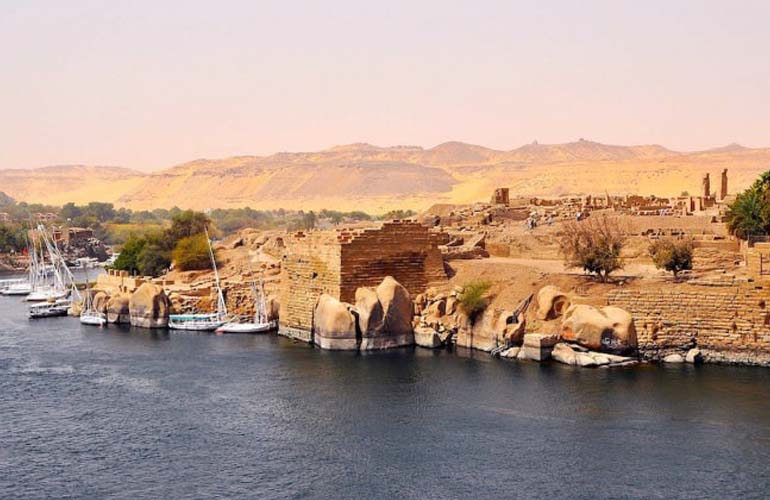The Elephantine Island In Aswan:
The origins of Elephantine Island date back to the pre-dynastic years, as evidenced by numerous objects found from that period. It has always provided an excellent position for those who wanted a defensive space with difficult access. The southern part of the island was even a fortified area most of the time.
Unfortunately, all these monuments were destroyed between 525 and 522 B.C., on the orders of Cambyses II, king of Persia and heir to Cyrus the Great. However, you can still visit the temple of Khnum and the famous Nilometer, which allowed the measurement of the flooding of the Nile river.
It was said on the book (The Lost Roads of Africa),
Elephantine is a very fertile island, full of palm groves and small orchards where mango and papaya trees grow. There is a small population center, which inhabits houses of one or two floors, painted in blue, and raised in very narrow streets by which it would be difficult to cross two donkeys at the same time. It smells of garbage and wet grass, and from the back yards of the houses, the loud cackling of the chickens and the shrill cock-a-doodle-doo come into the street.
Before 1822, there were temples to Thutmose III and Amenhotep III
On the island. They were destroyed during the campaign of Mehemed Ali, governor of Egypt on behalf of the sultan.
The first temple was the Temple of State, founded around 3,000 BC.
Most of the southern part of the island is occupied by the ruins of the Khnum temple. These ruins are built with the same stones as the step pyramid of the third dynasty. A small temple built by the local monarch Hegaib during the sixth dynasty also survives.

Meaning of Elephantine:
The island may have received its name because of its shape, which in aerial views is similar to that of an Elephant tusk, or because from the rounded rocks along the banks, it resembles that of the elephants.
The name Elephantine is the translation of the ancient Egyptian Ab or Abu which means “Elephant”, although the Arabs called it “The Island of Flowers”.
Elephantine island location
Elephantine Island is located in the waters of the Nile River, just at the height of the first waterfall, and therefore of the city of Aswan. It is the largest of the islands in the area. Its strategic location earned it great importance during the Pharaonic years and even late in the Hellenistic period, as it marks a natural boundary that served as a location for the guardians of the routes of southern Egypt.
Elephantine was the capital of the nome of Upper Egypt, and therefore it had its own triad. The gods worshipped there were Khnum, Satet and Anuket, and because of them was numerous temples were built of which some traces remain today.
” Elephantine Temple” – Temple of Khnum Elephantine island
One of the most important structures associated with the temple of Khnum is the nilometer. Elephantine was one of the main sites for measuring the level of the floods of the Nile River and for calculating the floods. It was there that the Greek astronomer Eratosthenes, during the reign of Ptolemy III Euergetes, made observations to calculate the circumference of the Earth.
The religious importance of the Aswan region increased considerably in subsequent periods with the Ptolemaic expansion of the worship of the goddess Isis on the island of Phyle.
The temples of Elephantine continued to flourish in the first and second centuries AD, but the problems of the Roman Empire and the notable incursions of the Blemians from the eastern desert forced Diocletian to abandon the border at Aswan in 298. When the edict of Theodosius closed the temples of the empire in 391, it did not happen in Philae; however, subsequent attempts at closure led to a conflict between the Roman and Nubian authorities.






